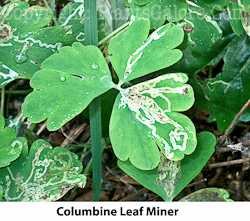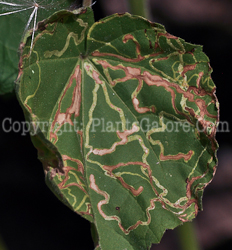|
 |
|
 |
|
 Symptoms: These critters cause translucent, see
threw trails, blisters and blotches on leaves that
eventually turn brown. Often, you can see tiny, dark
specks inside the trails that rattle around when you
shake the leaf. If you open a leaf and look into the
trails, you might find tiny green, yellowish or whitish
larvae. Certain species such as elms (Ulmus),
columbine (Aquilegia) and birch (Betula)
are routinely damaged by leaf miners. Symptoms: These critters cause translucent, see
threw trails, blisters and blotches on leaves that
eventually turn brown. Often, you can see tiny, dark
specks inside the trails that rattle around when you
shake the leaf. If you open a leaf and look into the
trails, you might find tiny green, yellowish or whitish
larvae. Certain species such as elms (Ulmus),
columbine (Aquilegia) and birch (Betula)
are routinely damaged by leaf miners.
More on birch
leaf miner,
columbine leaf miner,
elm leaf
miner.
|
|
Diagnosis:
Leaf miners are the larvae of species of flies, beetles
or sawflies. The adult comes around as soon as the
leaves fully expand and lay their eggs. The resulting
larvae feed between the upper and lower surfaces of the
leaves causing the translucent trails. After feeding for
a specific period of time, they either eat through the
leaf and drop to the ground to mature or they mature
inside the leaf, eat their way out and fly away.
Some of the species such
as the birch leaf miner have more than one generation
per growing season.
|
|
 Treatment: Since they spend most of their lives
inside the plant leaf, contact
insecticides normally do
not work well on these pests. So, the more standard
treatment is to use systemic insecticides that either
penetrate into the leaf or go from the roots through the
system of the plant. Treatment: Since they spend most of their lives
inside the plant leaf, contact
insecticides normally do
not work well on these pests. So, the more standard
treatment is to use systemic insecticides that either
penetrate into the leaf or go from the roots through the
system of the plant.
You need to know the life
cycle of the particular type of leaf miner in order to
determine the best time for treatment. Systemic products
take time to move through the system of the plant.
Check with your local
Extension
Service for current recommendations for control of
your particular type of leaf miner. |
|
 |
|
Note: We
have provided some general information and
observations on this topic aimed at the home
gardener. Before you take
any serious action in your landscape, check
with your state's land grant university's
Cooperative
Extension
Service for the most current,
appropriate, localized recommendations. |
|
|



